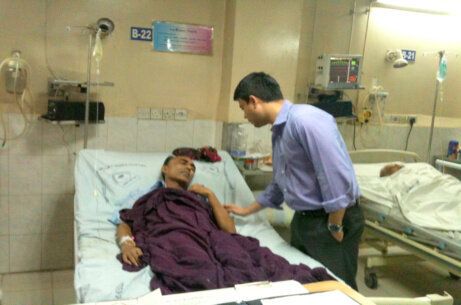Rajiv Chowdhury is the first Gates Cambridge scholar from Bangladesh, and is a final-year PhD student at Cambridge University. BRAVE is a collaborative study between the Department of Public Health and Primary Care at Cambridge and leading clinical and research institutes in Bangladesh. The author is the lead PI of the study mentioned in this blog.

When Aftab Ahmed (not his real name) suffered a heart attack, the doctors attending him in Dhaka were puzzled. Unlike many typical heart disease patients, Aftab was in his 20s, he did not have high blood pressure, diabetes or high levels of blood fats and had never smoked (classical factors commonly found in cardiovascular diseases/ CVD). Young and healthy patients like Aftab have now become increasingly common in the cardiology hospitals across Bangladesh.
Apart from unusual patient profiles, the country has also recorded some of the highest rates of CVD in South Asia in recent times and yet it remains the least studied population. In the late 1990s it was estimated that there would be a 100% increase in CVD across South Asia by 2020. But, when one looks at Bangladesh, there has already been a 3,500% increase. This high vascular burden in the local population seems consistent with Bangladeshis living abroad. In England, for example, Bangladeshis have the highest mortality from both heart attack and stroke events among all immigrant groups.
Although the 'classic' CVD risk factors apply to Bangladeshis, it seems likely that they may be affected by additional, as yet unrecognised, factors. The combination of atypical clinical patterns, a severely high burden of disease and absence of powerful studies to discover novel genetic, biochemical or lifestyle risk factors of CVD affecting this population prompted me to set up a case-control study called the "Bangladesh Risk of Acute Vascular Events (BRAVE)".
Initiated in 2011 as a pilot study in Dhaka (with part support from my own personal stipends from my Gates Cambridge Scholarship), this first-ever comprehensive cardiology research in Bangladesh has so far enrolled nearly 4,000 heart attack patients and healthy controls - exceeding any previous Bangladeshi study in scale. The initial results of BRAVE are already showing promising findings, with several environmental contaminants (eg arsenic in the blood) and nutritional elements (eg zinc deficiency) emerging as important drivers for heart attacks in this population.
Several genetic and biochemical analyses are also currently under way. These results are significant as they show that the CVD risk profile in low-income countries might be different from that in higher income countries and may potentially be reinforced by local factors which are largely preventable with appropriate public health strategies.
BRAVE aims to recruit 20,000 participants over the next few years (depending on further funding from leading health charities), making this one of the largest epidemiological studies in the region. Information and bioresources collected in BRAVE will then be used to test novel hypotheses relating to potential risk factors to help shape local and global cardiopreventive policies.
